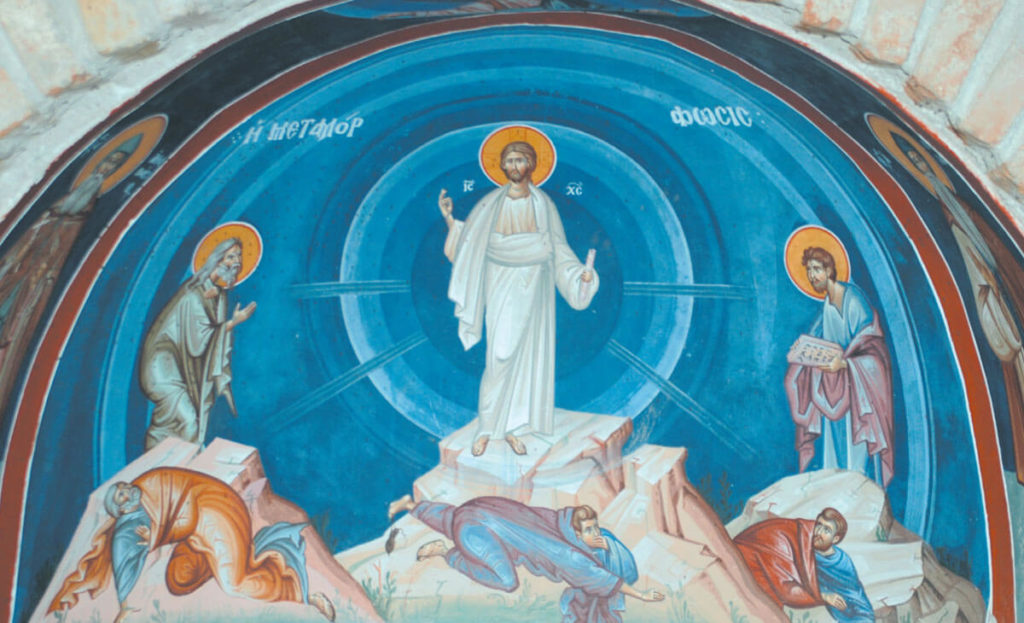
Luke characterizes Jesus as a man of prayer. In his gospel Luke makes explicit why Jesus goes up the mountain. He goes to pray. It is praying that transforms Jesus’ face and makes his clothes dazzle.
Peter, James, and John sleep as Jesus prays. But Luke’s omniscient narrator takes us inside Jesus’ mountaintop experience. As he prays, Jesus’ inner life becomes transparent in his outward appearance, just as our values and commitments show through in our bodies over our lifetimes. His spirit and body are one. Two great prophets of Israel’s past come alive in Jesus’ consciousness to lead him on as he prepares to go to Jerusalem where conflicts await that lead to his death and resurrection.
Awake, Peter, James, and John see what Luke wants us readers to see and what the Church wants us to reflect upon — Jesus in glory and in the company of the prophets Moses and Elijah.
- Who do you know whose spirit seems transparent in his or her face and body?
- Who like Moses and Elijah are holy people from your past who help you envision your call into the future?
Jesus prays regularly in Luke’s gospel. After he accepts John’s baptism, Jesus is praying when the Spirit comes upon him and anoints him (3.21). In the midst of teaching and healing people in Galilee, Jesus withdraws to deserted places to pray (5.15). Before he chooses 12 of his disciples as apostles, he spends a night on the mountain in prayer (6.12).
Jesus teaches his disciples to address God intimately as “Father” when they pray (11.1-4). After he eats his last supper with his disciples, Jesus goes out to the Mount of Olives and prays, “Father, if you are willing, let this cup pass from me; yet not my will but yours be done” (22.42).
His prayer on the mount of transfiguration is a turning point in his ministry. A few verses later Jesus “sets his face for Jerusalem” (9.51).
This gospel calls us to set our sights toward Easter, to enter more deeply the mystery of Jesus’ death and resurrection, which transforms us still. Luke calls us to prayer — to take time as Jesus does in his 40 days in the wilderness to integrate the Spirit’s urgings into our lives.
Jesus prays outdoors on mountains, in deserted spots, in the darkness of night. He seizes moments of reflection in the created world — where heights lay open possibilities in every direction or the night shelters his struggle. On the mount of transfiguration Jesus models the transforming power of prayer in finding one’s way and facing struggles.
- How has prayer led you into action? To insight? To try again?
- What conflicts seem inevitable in your life or mission?
Only Luke tells us what Jesus, Moses, and Elijah are talking about — the exodus Jesus is about to accomplish in Jerusalem. Luke’s choice of the word exodus is deliberate. The word names the event in Israel’s history when God led the people out of slavery in Egypt. It means departure or going forth. From the mountain Jesus sees his exodus ahead, his going forth.
This iconic gospel places Jesus with the two prophets in Israel’s history who have interacted most intimately with God. To evoke their communion with the Holy, the biblical storytellers favor clouds, shadows, light, fire, mountaintops, and utter silence.
Moses first experiences God in a burning bush, takes off his shoes in this holy place, and asks God’s name. To receive the commandments, God summons Moses to the top of Mt. Sinai, where he spends six days enshrouded in clouds with God and then 40 days and nights, so long that the people make a golden calf to worship.
Moses pleads with God for the people and returns to the mountaintop where God relents. Moses seeks to see God face to face but God tucks him in a crevasse to see God from the back lest he die. Moses’ face reflects God’s glory when he comes down, so he has to cover his face before the people (Exodus 34.20-35).
Elijah is the only prophet left in Israel when he has a showdown with the priests of Baal, the Canaanite storm god. He has to run for his life to escape King Ahab and Queen Jezebel. Angels feed Elijah food that lasts during his 40-day journey to Horeb, the mountain of God, where Moses and the people met God 500 years earlier. Elijah stands on the mountain through wind, an earthquake, and fire but hears God in the sheer silence afterwards, a voice sending him back to anoint new kings and prophets (1 Kings 19).
In the transfiguration a cloud overshadows Jesus, Peter, James, and John. A voice from the cloud identifies Jesus, “My son, my chosen one.” In the exodus from Egypt God accompanies the Hebrews in the wilderness as a cloud by day and fire by night. The transfiguration shows the God of Israel claiming Jesus as Son and prophet.
Like the lawgiver Moses, who led an exodus from slavery to freedom, Jesus leads an exodus from death to new life and teaches his new law of love. Like the prophet Elijah, Jesus will confront the officials of empire and temple after his prayer in the silent stillness of a mountaintop. Peter, James, and John follow Jesus in this line of prophets.
- How are your God moments a source of hope for you?
- What spiritual experience has transformed you and stuck with you as a deep anchor in your being?
